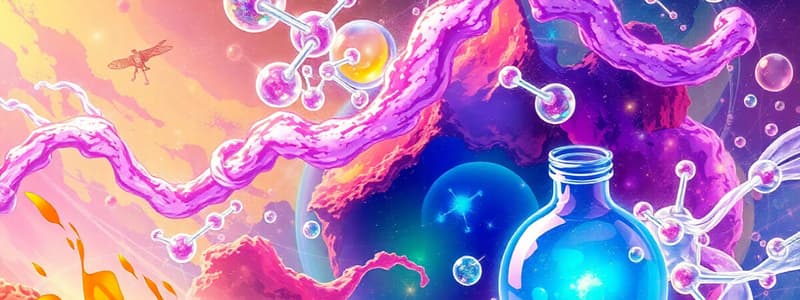Podcast
Questions and Answers
Which statement best describes a pure substance?
Which statement best describes a pure substance?
- Any material that can be separated into simpler substances.
- A combination of two or more substances.
- A heterogeneous mixture of various components.
- A material made up of only one type of atom or molecule. (correct)
Which of the following is an example of a mixture?
Which of the following is an example of a mixture?
- Sodium chloride (NaCl)
- Water (H2O)
- Air (correct)
- Gold (Au)
What distinguishes a compound from an element?
What distinguishes a compound from an element?
- A compound consists of one type of atom.
- A compound can be broken down into simpler substances. (correct)
- An element is always a homogenous mixture.
- Compounds do not have specific chemical formulas.
How can changes in subatomic particles affect a substance?
How can changes in subatomic particles affect a substance?
Which of the following correctly identifies an element?
Which of the following correctly identifies an element?
What defines a mixture?
What defines a mixture?
Which of the following statements about compounds is true?
Which of the following statements about compounds is true?
Which of these scenarios demonstrates a pure substance?
Which of these scenarios demonstrates a pure substance?
Flashcards
Element
Element
A substance made up of only one type of atom.
Atom
Atom
Smallest unit of an element that retains the chemical properties of that element.
Compound
Compound
A substance made up of two or more elements chemically combined in a fixed ratio.
Mixture
Mixture
Signup and view all the flashcards
Homogeneous mixture
Homogeneous mixture
Signup and view all the flashcards
Heterogeneous mixture
Heterogeneous mixture
Signup and view all the flashcards
Pure substance
Pure substance
Signup and view all the flashcards
Mixture
Mixture
Signup and view all the flashcards
Study Notes
Lesson 2: Classification of Matter
- Objectives:
- Compare and contrast pure substances and mixtures
- Differentiate between elements and compounds
- Success Criteria:
- All students will differentiate between pure substances and mixtures
- Most students will differentiate between elements and compounds
- Some students will analyze changes in subatomic particles (e.g., adding or losing electrons)
- Engage: Watch a video
- https://youtu.be/m7nOzfZEem8 (Video to compare pure substances and mixtures)
Classification of Matter
- Substance: Matter that has a consistent composition. It has a fixed combination of atoms.
- Definiton: Matter with a composition that is always the same
- Examples: Elements and compounds
- Element: A substance made of only one type of atom.
- Examples: Aluminum, Oxygen, Chlorine, Carbon
- Compounds: A substance containing two or more different elements that are chemically bonded together.
- Examples: Water (H₂O), Sodium Chloride (NaCl), Methane (CH₄)
- Types of Substances:
- Elements:
- Consist of only one type of atom.
- Examples in the presentation: Aluminum (Al), Oxygen (O), Chlorine (Cl), and Carbon (C) shown as images (along with other chemical symbols)
- Elements:
- Elements on the Periodic Table:
- Most elements are considered metals. These are on the left side of the periodic table like Aluminium.
- Metalloids act as intermediate on the periodic table between metals and nonmetals like Boron.
- Nonmetals are on the right side like Oxygen.
- Atoms of Elements:
- Atoms are the fundamental building blocks.
- Each element has a unique number of protons, which is reflected in its position on the periodic table.
- For example, aluminum has 13 protons while oxygen has 8.
- Atoms of the same element can exist in different forms (individually or in pairs), as seen in the examples of Aluminum(individually) and Oxygen(in pairs).
Explore: Element
- Definition: A substance that consists of just one type of atom, such as Aluminum, Oxygen, Chlorine, or Carbon.
Explain: Element
- Figure 3: Periodic table showing elements, with examples of Aluminum and Oxygen (and their protons and atomic mass).
- Elements contain one type of atom.
- Most elements are metals.
- Metals like aluminum are on the left side of the periodic table.
- Metalloids are between metals and nonmetals.
- Nonmetals are on the right side.
- Figure 4: (Images of the arrangement of atoms)
- Some elements are made of more than one atom (e.g., Hydrogen H₂).
- Elements consist of one type of atom (e.g., Helium He)
- Compounds consist of two or more different types of atoms bonded together (e.g., Carbon Dioxide CO₂).
Elaborate: Task
- Differentiate elements from compounds:
- Elements: Consist of one type of atom
- Compounds: Consist of two or more types of atoms chemically combined
Evaluate: Activity Game
- An activity game is provided to help students evaluate and identify elements and compounds.
- https://wordwall.net/resource/23669223/atoms-elements-and-compounds-match-up for a matching activity.
Studying That Suits You
Use AI to generate personalized quizzes and flashcards to suit your learning preferences.




